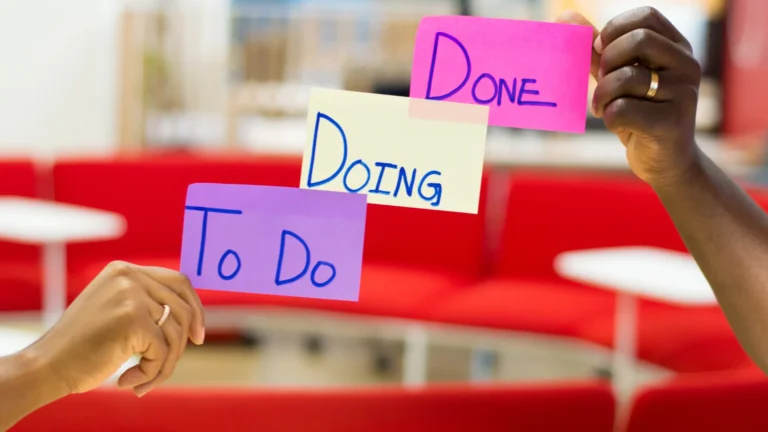Do you know that?
If you spend most of your time sitting in front of a computer or hunched over a desk, you are at an increased risk of developing muscle, circulation and joint problems.
Problems that can occur after sitting for a long time:
Prolonged sitting can lead to poor blood flow to the muscles and joints. In addition, it leads to:
- back pain
- neck pain
- headache
- pot belly
- Wrist strains
Benefits of neck and back exercises at the desk
Back training with back exercises protect against chronic stress
Work can be stressful and likely plays a role in personal stress as well. It doesn’t matter what kind of work you do; at some point you’re bound to get stressed about something. Acute stress is generally considered beneficial as it helps improve focus and concentration. Chronic stress, on the other hand, is harmful and can be difficult to control when it stems from severe, continuous stress and environmental demands. Stress at work has both physical and psychological consequences and can cause back problems and lead to back pain. You may be stressed out by a heavy workload, uncomfortable working conditions, or conflicts with colleagues.
Exercise neck and back muscles to improve productivity and performance
When you move and train your back with back exercises, you’ll have more energy and be more productive for the rest of the day. Many people set out to run or go to the gym every day, but when they get home they’re so exhausted from the day’s events that all they want to do is curl up and watch TV. Even if the day wasn’t very tiring, the fact that you’ve spent most of the day sitting can make you feel unmotivated to exercise.
A good sleep
A large proportion of citizens are dissatisfied with their nightly sleep. Of course, there are a variety of causes for this, including drinking too many caffeinated drinks and watching Netflix too close to bed. Physical activity during the day, on the other hand, improves the quality of sleep at night.
There are many other benefits, such as:
Some of the best known and most common desk exercises
In this article, we show neck and back exercises with a stretch and movement sequence that you can perform at your desk in your office chair without getting up to optimize posture and muscle building. Ideally, you would get up every 30 minutes and do these core and upper back exercises. But let’s say you really can’t get up and have to keep working. You don’t even have to get up to do these stretches.
For this exercise program you only need a standing desk and a chair as your desk exercise equipment.
Exercises: 1 / 10
Slowly move your chin down toward your chest. Place your hand on the back of your head to hold the position. Hold the position for 10 seconds. Then slowly move your head back. Place your hands on the back of your head to hold the position. Hold the position for 10 seconds.
Exercises: 2 / 10
Roll your shoulders up and back in a circular motion. Hold the position for 20 seconds.
Exercises: 3/10
Extend your arm forward, palm facing up, and gently pull your fingers down. Stretch for 20 seconds. Turn your wrist and gently pull your fingers toward you. Hold for 20 seconds.
Exercises: 4/10
Place your right hand on the outside of your left knee with your feet shoulder-width apart, and then slowly look over your right shoulder. Repeat this 5 times on both sides.
Exercises: 5/10
Reach up with your left arm, place your right hand on your wrist and gently pull through. Repeat the exercise on the other side.
Exercises: 6 / 10
For this “strong back” exercise, place your arms behind your head. And you’re pacing your upper back too. This gives you a certain mobility in the thoracic spine, i.e. in the upper back. You don’t want to arch your lower back, you only want to move from your upper back and mid-back when doing back workouts. Start by putting your arms behind your head. You’ll do the seated upper mobility exercise for three reps, so three slow reps that you don’t want to do too fast. Again, it’s very important not to arch your lower back.
So try to bring your elbows up, but only do as much movement as possible.
Exercises: 7/10
For this exercise, bring your arms into a W, and then push yourself up into a Y, into the letter Y. Straighten them, then bring them down. Squeeze your shoulder blades together and then straighten them back up into a Y, giving your upper back a nice stretch.
Extend your arms and stretch them back into a Y. That was the first exercise. And we’re doing five of them, that’s two, so stretch and try not to shrug as you do this exercise, straighten your arms up to feel a stretch in your spine and upper back , and then squeeze your shoulder blades together on the way down and just try to move through that movement.
Exercises: 8/10
In this exercise, you will simply rotate. Put one arm behind the chair so that you feel a nice twist in your back. And when you’ve done one side, switch to the other side. So you can put one arm behind the chair and one on the desk and so on. You simply turn and hold this position.
When you’re done, roll onto one side and hold it for 10 seconds so that you feel a nice twist in your lower and upper back. Once you’ve made one side, move on to the other side, so switch hands now. Grab the other arm behind the chair and push away with the other arm for extra rotation and hold your breath.
Exercises: 9/10
Rest your elbows on the desk and step your feet into this chest stretch. Just feel your upper back and triceps.
Exercises: 10/10
For this exercise, place your palms down. Walk your feet even further and feel an even greater stretch. start putting them in sequence.
Place both elbows on the table, roll your feet, and bring your head between your hands. You can also clasp your hands and hold this position for 20 seconds.
Be careful not to arch your lower back and keep your pelvis bent at all times. And just keep that nice stretch in place. After that, place your palms on the desk and step your feet out even further and hold the stretch for another 20 seconds. So this is a bigger stretch that you should feel more from your hands to your hips. Again, don’t arch your lower back, but hold the position and breathe calmly.
Avoid back pain by stretching your lower back
The back, especially the lower back, bears the brunt of the stress of an unhealthy lifestyle. Stand up and stretch on your tiptoes for 10 to 30 seconds to relieve a ton of stress.
Remaining seated in your chair, spread your knees about shoulder-width apart and bring your head toward your knees rather than touching your toes. Dropping your head helps stretch your lower back and release tension. To support the work while stretching your shoulders, interlace your fingers behind your back and stretch them up.
If you do any of these exercises for a minute once an hour, you will feel a reduction in lower back discomfort.
“desk cat”/ “cows”
Normally you do this back gymnastics on all fours. But since we are sitting at a desk, we do the exercise right at the desk, sitting on the chair with our hands stretched out in front. Sit up straight here. In this position we will tuck our chin and back. Once you’re in that position, we’ll just reverse it, look up, and stick our chest out trying to arch our back and repeat 10 times.
tricep dips
Try a series of bench presses
Place your hands on the edge of the bench and keep your arms semi-bent with your elbows as close to your body as possible. The legs are slightly bent, leaning on the heels – muscle contraction. In a slow and controlled motion, lower yourself until your elbows form an angle of about 90. And slowly return to the starting position for the triceps exercise (muscles involved, breathing). Some common mistakes are fully straightening your arms on the ascent and flexing your elbows on the descent.
Single leg squat
Stand on one leg and one foot, with your hands at your sides.
Push your hips back and straighten toward the floor. Stop when your back is parallel to the floor. Return to the starting position. Repeat the exercise at least 5 times on each leg.
raise legs
Sit upright in your chair with good posture. Raise one leg straight up until your hamstring releases from the seat. Hold the exercise for at least 20 seconds and repeat on the other side. Switch legs.
Sit up straight with your feet flat on the floor. Lift one leg until it is parallel to the floor and straight in front of you by tightening the muscle at the front of your thigh. Hold the leg for a second, then lower it back to the starting position. Repeat the exercise 10 times on each side.
Push-ups at the desk
Bend forward and place both hands on the edge of the table to form an angle in your body. Bend your elbows and lower your chest toward the desk while keeping your elbows close to your torso to perform a push-up. Do three sets of 10 to 15 reps. Make it harder: Do push-ups while holding onto the cushion of your chair.
Okay that’s it, now that you’re done just go to your desk and stand back in front of your desk with your hands and you can get back to work.
What Causes Carpal Tunnel Syndrome?
It is a genetic disease. But sometimes, wrist strains, excess calories, and poor circulation can increase the likelihood of this condition.
bending and releasing
For this exercise you need a table and an exercise ball. Place the ball on the table and place the bottom of your forearm directly on the ball. Scan back and forth and pinpoint any tender spots. If you find a tender spot, you need to apply constant pressure or make small micro circles until the pain and intensity of that spot subsides. Do this for a minute.
shake it out
Start with your hands in front of you, palms facing the floor, and move your head left and right. Hold the movement for 10-15 seconds. Repeat this exercise three times throughout the day.
Tips to prevent Carpel Syndrome
- When working with a pen, computer mouse, or other device, avoid a tight grip.
- Give your hands and wrists a break often.
- Stretch your hands and wrists daily.
- Rest your wrists in a neutral position on the desk, or use an adaptive mousepad to avoid excessive wrist flexion or extension.
- Make sure your shoulders and back are comfortable. Be careful not to slouch.
- Sit so that your knees are slightly lower than your hips and your computer is at eye level.
- Don’t crane your neck to look sideways at the computer, but stand it in front of you.
- Put your feet flat on the floor instead of tucking them under the chair.
- Use splints or supports to relieve pain.
Yoga at the desk
- Stand on the edge of your seat. Place both legs in a straight line and place both feet on the floor. Sit up straight. Take a deep breath and exhale long.
- Now lower your chin to your chest and slowly roll (nod) your head.
- Now start shaking your head left and right. slow it down And now draw circles with your nose. In one direction and in the other.
- raise your heart Sit up straight. Now roll your shoulders a few times.
- Bring your right hand to the outside edge of your left leg and bring your left hand behind you for a gentle twist. Breath in and breath out. You can also place your right hand on the edge of your desk.
- Grasp your swivel chair with your left hand and stretch your right arm up and over it. Bring your left hand to the chair’s right armrest for a deeper stretch. Gently let them return to the center and guide them to the other side.









